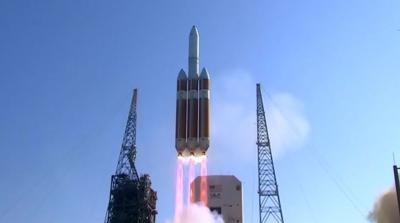Tue, Jul 03, 2012
Launch Marks the Inaugural Flight of the RS-68A Engine
A United Launch Alliance (ULA) Delta IV Heavy rocket carrying a payload for the National Reconnaissance Office (NRO) lifted off from Space Launch Complex-37 at Cape Canaveral Air Force Station at 0915 EDT Friday. Designated NROL-15, the mission is in support of national defense. "Today's successful launch of the NROL-15 mission is the third of four launches for the NRO this year and the second EELV launch for the NRO in just nine days," said Jim Sponnick, ULA vice president, Mission Operations. "We congratulate the combined NRO, U.S. Air Force and ULA team along with our mission partners for their continued focus on mission success as we deliver the critical capabilities to support the soldiers, sailors, airmen and Marines."

This mission was launched aboard a Delta IV Heavy configuration vehicle, which featured a center common booster core along with two strap-on common booster cores. Each common booster core was powered by an RS-68A Liquid Hydrogen/Liquid Oxygen engine producing 797,000 pounds of thrust. A single RL10 Liquid Hydrogen/Liquid Oxygen engine powered the second stage. The booster and upper stage engines are both built by Pratt & Whitney Rocketdyne. The payload was encased by a five-meter diameter (16.7-foot diameter), 65-foot, metallic tri-sector payload fairing. ULA constructed the Delta IV Heavy launch vehicle in Decatur, Ala.
This was the inaugural flight of the RS-68A engine, which was upgraded from the RS-68 under the Heavy Upgrade program for the Delta IV Heavy configuration. With the RS-68A engine upgrade, the thrust has been increased from approximately 758,000 pounds to 797,000 pounds and the engine overall efficiency (specific impulse) has also been increased.
"The upgraded Delta IV Heavy vehicle was developed with an extremely thorough and comprehensive system engineering process by the ULA and Pratt-Whitney Rocketdyne teams, along with substantial involvement by our U.S. government customers," said Sponnick. "Congratulations to the entire team on today's successful inaugural flight of the upgraded Delta IV Heavy launch vehicle and the RS-68A engine."
ULA's next launch is the Atlas V NROL-36 mission for the NRO scheduled Aug. 2 from Space Launch Complex-3 at Vandenberg Air Force Base, CA.
(Image from ULA video)
More News
Light Gun A handheld directional light signaling device which emits a brilliant narrow beam of white, green, or red light as selected by the tower controller. The color and type of>[...]
"The journey to this achievement started nearly a decade ago when a freshly commissioned Gentry, driven by a fascination with new technologies and a desire to contribute significan>[...]
Aero Linx: JAARS, Inc. For decades now, we’ve landed planes on narrow rivers and towering mountains. We’ve outfitted boats and vehicles to reach villages that rarely se>[...]
"Our driven and innovative team of military and civilian Airmen delivers combat power daily, ensuring our nation is ready today and tomorrow." Source: General Duke Richardson, AFMC>[...]
Aircraft Conflict Predicted conflict, within EDST of two aircraft, or between aircraft and airspace. A Red alert is used for conflicts when the predicted minimum separation is 5 na>[...]
 ANN's Daily Aero-Term (04.20.24): Light Gun
ANN's Daily Aero-Term (04.20.24): Light Gun Aero-News: Quote of the Day (04.20.24)
Aero-News: Quote of the Day (04.20.24) ANN's Daily Aero-Linx (04.21.24)
ANN's Daily Aero-Linx (04.21.24) Aero-News: Quote of the Day (04.21.24)
Aero-News: Quote of the Day (04.21.24) ANN's Daily Aero-Term (04.21.24): Aircraft Conflict
ANN's Daily Aero-Term (04.21.24): Aircraft Conflict



